A visit to one of the great cities overwhelms the senses. Voices chatter in countless different languages. The smells of cooking in dozens of different cuisines mingle with the odors of crowded streets and poor sanitation. Buildings in myriad architectural styles display the diverse origins of their inhabitants.
And the people themselves—people of varying size, shape, and color dressed in a dazzling spectrum of styles and hues—represent many different species, from diminutive hin and stout dwarves to majestically beautiful elves, mingling among a variety of humans.
Dwarves, elves, gnomes, hin, and humans are the most common species to produce the sort of adventurers who make up typical parties. Aasimar, bugbears, centaurs, firbolg, genasi, goblins, goliaths, hobgoblins, kalashtar, kobolds, minotaurs, orcs, shifters, ssurran, tabaxi, thri-kreen, tieflings, and vayemniri less commonly adventurer. Androids, azarketi, changelings, fairies, gith, itarii, nagaji, and warforged rarely become adventurers. Not every intelligent species of the multiverse is appropriate for a player-controlled adventurer.
Choosing a species
Your choice of species affects many different aspects of your character. It establishes fundamental qualities that exist throughout your character’s adventuring career. When making this decision, keep in mind the kind of character you want to play.
Your character species not only affects your traits but also provides the cues for building your character’s story. Each species’ description in this section includes information to help you roleplay a character of that species, including personality, physical appearance, and features of society. These details are suggestions to help you think about your character; adventurers can deviate widely from the norm for their species. It’s worthwhile to consider why your character is different, as a helpful way to think about your character’s background and personality.
Common species
Dwarf
Kingdoms rich in ancient grandeur, halls carved into the roots of mountains, the echoing of picks and hammers in deep mines and blazing forges, a commitment to clan and tradition, and a burning hatred of goblins and orcs—these common threads unite all dwarves.
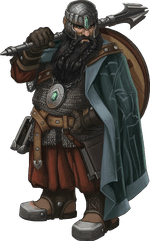
Elf
Elves are a magical people of otherworldly grace, living in the world but not entirely part of it. They live in places of ethereal beauty, in the midst of ancient forests or in silvery spires glittering with faerie light, where soft music drifts through the air and gentle fragrances waft on the breeze. Elves love nature and magic, art and artistry, music and poetry, and the good things of the world.

Gnome
Gnomes are distant relatives of the fey, and their history tells of a time when they lived in the fey’s mysterious realm, a place where colors are brighter, the wildlands wilder, and emotions more primal. Unknown forces drove the ancient gnomes from that realm long ago, forcing them to seek refuge in this world; despite this, the gnomes have never completely abandoned their fey roots or adapted to mortal culture. Though gnomes are no longer truly fey, their fey heritage can be seen in their innate magic powers, their oft-capricious natures, and their outlooks on life and the world.
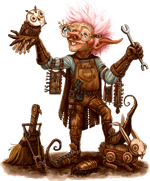
Hin
The comforts of home are the goals of most hin’ lives: a place to settle in peace and quiet, far from marauding creatures and clashing armies; a blazing fire and a generous meal; fine drink and fine conversation. Though some hin live out their days in remote agricultural communities, others form nomadic bands that travel constantly, lured by the open road and the wide horizon to discover the wonders of new lands and peoples. But even these wanderers love peace, food, hearth, and home, though home might be a wagon jostling along a dirt road or a raft floating downriver.
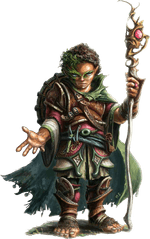
Human
In the reckonings of most worlds, humans are the youngest of the common species, late to arrive on the world scene and short-lived in comparison to dwarves, elves, and dragons. Perhaps it is because of their shorter lives that they strive to achieve as much as they can in the years they are given. Or maybe they feel they have something to prove to the elder species, and that’s why they build their mighty empires on the foundation of conquest and trade. Whatever drives them, humans are the innovators, the achievers, and the pioneers of the worlds.

Uncommon species
Aasimar
Aasimar are imbued with a divine energy that blazes within them. They are charged by the powers of good to guard the weak, to strike at evil wherever it arises, and to stand vigilant against the darkness. From a young age, an aasimar receives advice and directives that urge to stand against evil.
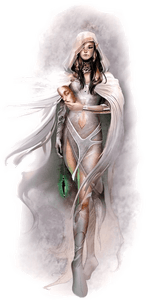
Bugbear
Bugbears are the hulking cousins of goblins and hobgoblins. With roots in the Feywild, early bugbears resided in hidden places, in hard-to-reach and shadowed spaces. Long ago and from out of the corner of your eye, they came to the Material Plane, urged to spread throughout the multiverse by the conquering god Maglubiyet. Centuries later, they still bear a fey gift for lurking just out of sight, and many of them have sneaked away from that god’s influence.
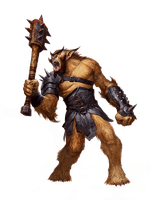
Centaur
Centaurs have a love of wide spaces and the freedom to travel. As much as they can, centaurs run—in wide plazas, spacious parks, and expanses of rubble and ruin. They race the wind, hooves thundering and tails streaming behind them, until the next wall looms in their path and brings them to a stop.
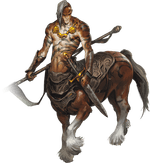
Firbolg
Firbolg tribes cloister in remote forest strongholds, preferring to spend their days in quiet harmony with the woods. When provoked, firbolgs demonstrate formidable skills with weapons and druidic magic.
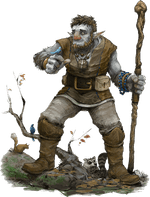
Genasi
Those who think of other planes at all consider them remote, distant realms, but planar influence can be felt throughout the world. It sometimes manifests in beings who, through an accident of birth, carry the power of the planes in their blood. The genasi are one such people, the offspring of genies and mortals.
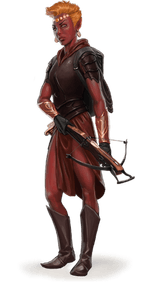
Goblin
The convoluted histories other people cling to don’t interest goblins. These small folk live in the moment, and they prefer tall tales over factual records. The wars of a few decades ago might as well be from the ancient past. Misunderstood by other people, goblins are happy how they are. Goblin virtues are about being present, creative, and honest. They strive to lead fulfilled lives, rather than worrying about how their journeys will end. To tell stories, not nitpick the facts. To be small, but dream big.
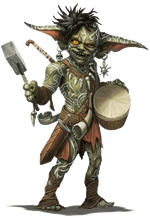
Goliath
At the highest mountain peaks—far above the slopes where trees grow and where the air is thin and the frigid winds howl—dwell the reclusive goliaths. Few folk can claim to have seen a goliath, and fewer still can claim friendship with them. Goliaths wander a bleak realm of rock, wind, and cold. Their bodies look as if they are carved from mountain stone and give them great physical power. Their spirits take after the wandering wind, making them nomads who wander from peak to peak. Their hearts are infused with the cold regard of their frigid realm, leaving each goliath with the responsibility to earn a place in the tribe or die trying.
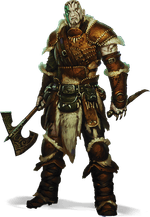
Hobgoblin
Fierce and militaristic, hobgoblins survive by conquest. The raw materials to fuel their war machines come from raids. Naturally ambitious and envious, hobgoblins seek to better themselves at the expense of others of their kind, yet in battle they put aside petty differences and fight with discipline rivaling that of the finest soldiers. Hobgoblins have little love or trust for one another, and even less for outsiders. Life for hobgoblins consists of duty to those of higher station and the rare opportunities to seize personal glory and elevate their status.
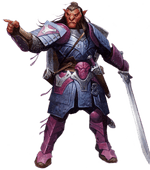
Kalashtar
The kalashtar are a compound people, created from the union of humanity and renegade spirits from the plane of dreams—spirits called quori. Kalashtar are often seen as wise, spiritual people with great compassion for others. There is an unmistakable alien quality to the kalashtar, though, as they are haunted by the conflicts of their otherworldly spirits.
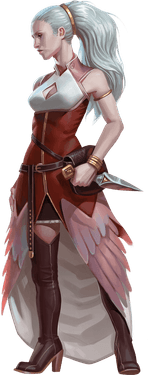
Kobold
Kobolds proudly claim kinship to dragons. They are hardworking, clever, and blessed with a natural talent for mechanical devices and mining. Kobold tactics specialize in traps and ambushes.
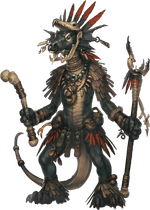
Minotaur
Minotaurs are strong in body, dedication, and courage. They are at home on the battlefield, willing to fight for their various causes. They combine a burning fury in battle with keen tactics that make them excellent commanders as well as valuable shock troops.
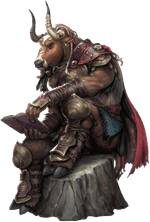
Orc
Orcs are a tribal people. These tribes are often nomadic in nature, searching for resources. When resources grow scarce, orc tribes can form a larger warband that seeks to take resources from others. Orcs are proud and strong.
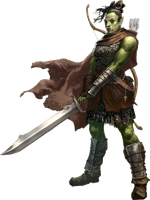
Shifter
Shifters are sometimes called the weretouched, as many believe that they are the descendants of humans and lycanthropes. They are humanoids with a bestial aspect; while they cannot fully change shape, they can temporarily enhance their animalistic features—a state they call shifting. Whatever their origins, shifters have evolved into a unique species. A shifter walks on the knife’s edge between the wilds and the world around them. Do they embrace their primal instincts or the path of civilization?
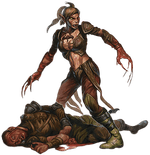
Ssurran
Ssurran move through the societies of other humanoids with the steely reserve of born predators. They have a well-deserved reputation as outstanding rangers and unsentimental fighters. Though ssurran have adapted to many different environments, many of them still prefer to remain near bodies of water, using their ability to hold their breath to their advantage. As a result, ssurran usually prefer equipment that is not easily damaged by moisture, eschewing leather and metal for gear made of stone, ivory, glass, and bone.
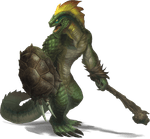
Tabaxi
Tabaxi are natural explorers who rarely tire of trailblazing. While most tabaxi are nimble, capable, and often active creatures, there is also a strong tendency among some tabaxi to engage in quiet contemplation and study. Such individuals are interested in finding new solutions to age-old problems and questioning even the most steadfast philosophical certainties of the day. They are curious by nature, and tabaxi culture never discourages inquisitiveness, but rather fosters and encourages it. Many are seen as quirky extroverts by members of other species, but within tabaxi tribes there is no shame attached to minor peculiarities, eccentricities, or foolhardiness. All but the most inwardly focused tabaxi enjoy being the center of attention, but not at the expense of their tribe, whether it’s the one the tabaxi are born into or the tribe they choose through the bonds of friendship with other creatures. Tabaxi tend to be both generous and loyal to their family and friends.
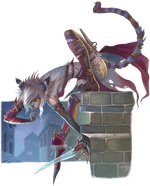
Thri-Kreen
Thri‐kreen are intelligent beings born from eggs that possess a mindset very different from any other humanoid. They roam the wastes in packs, hunting for food day and night. Thri‐kreen are quick and agile and make fearsome fighters, feared throughout the wastes. They refer to thri-kreen who have become city dwellers as “tohr-kreen,” meaning “settled person,” whereas thri-kreen means “wanderer-person.”
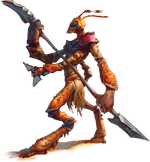
Tiefling
To be greeted with stares and whispers, to suffer violence and insult on the street, to see mistrust and fear in every eye: this is the lot of the tiefling. And to twist the knife, tieflings know that this is because a pact struck generations ago infused the essence of Asmodeus—overlord of the Nine Hells—into their bloodline. Their appearance and their nature are not their fault but the result of an ancient sin, for which they and their children and their children’s children will always be held accountable.
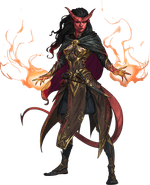
Vayemniri
Vayemniri walk proudly through a world that greets them with fearful incomprehension. Shaped by draconic gods or the dragons themselves, the vayemniri are proud, honorable, and relatively rare. Slaves to dragons on their world of origin, they are now a free people looking for a place and purpose in their new world.
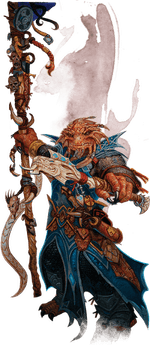
Rare species
Android
Androids’ bodies are artificial, though made of materials that mimic the flexibility, shape, and density of human flesh and bone. It can be difficult to differentiate the two, but in the right light androids’ alien nature is revealed by the metallic sheen in their eyes and the biological, tattoo-like circuitry that riddles their skin. Their organs mirror those of humans so well that only by examining the materials and makeup of these systems—which use sheeny oils and polymer alloys rather than blood and marrow—could one guess that their physiology is alien.

Azarketi
The enigmatic and reclusive azarketi (known to some as “Low Azlanti”) are the aquatic descendants of the vanished Azlanti humans. When Earthfall struck Golarion and the continent of Azlant was shattered, most of the Azlanti dwelling died in the fires or drowned in the waves. Yet a number found succor with their undersea aboleth enemies. For reasons that remain unknown to this day (but which surely have nothing to do with compassion), the aboleths rescued a small fraction of these drowning humans, warping their flesh to help them survive in the aboleths’ uncontested undersea realm. Yet with that action, the aboleths seemed to lose interest, and in the thousands of years that followed, the azarketi formed a society of their own.
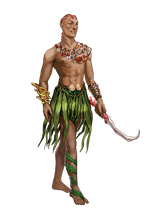
Changeling
Changelings are the offspring of hags and their lovers taken through magic or madness. Dropped off on doorsteps of prospective foster parents, changelings are raised by strangers. Typically tall, slender, and attractive, changelings otherwise resemble their fathers’ species. Their hair colour is most commonly a light shade of silver followed by platinum and blond. In rarer cases their hair can be pale shades of green, pink and blue. Their mismatched colored eyes, abnormally pale skin, and hair color hint at their true heritage. At puberty, changelings receive “the call,” a hypnotic spiritual voice that beckons them to travel and discover their true origins. Changelings who ignore this call choose their own destiny; those who heed it discover their “mother” and may come into great power by transforming into hags themselves.
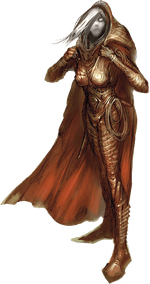
Fairy
Fairies are a wee folk. Infused with the magic of the Feywild, most fairies look like Small elves with insectile wings.
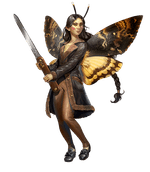
Gith
The warlike githyanki and the contemplative githzerai are a sundered people—two cultures that utterly despise
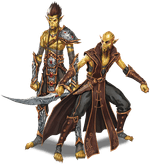
Itarii
Sequestered in high mountains atop tall trees, the itarii are reclusive avian humanoids devoted to their homelands and their tribes. They defend their precious communities with broad wingspans and razor talons.
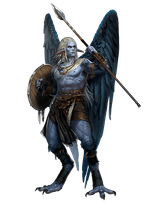
Nagaji
Nagaji were originally humans who transformed themselves through ancient rituals. Most nagaji were corrupted into monsters by those rites, but some nagaji instead became a new people who mix characteristics of humans and snakes.
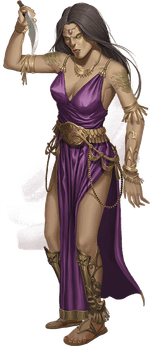
Warforged
The warforged were built to fight. While the first warforged were mindless automatons, resources were devoted to improve these steel soldiers. An unexpected breakthrough produced sapient soldiers, giving rise to what some have only grudgingly accepted as a new species. Warforged are made from wood and metal, but they can feel pain and emotion. Built as weapons, they must now find a purpose beyond war. A warforged can be a steadfast ally, a cold-hearted killer, or a visionary in search of meaning.
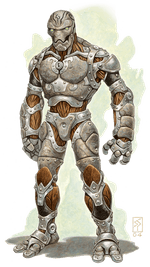
Mixed heritage
Species are not always so cut and dry. In metropolitan areas especially, the lines between species becomes very blurry. To play a character with mixed heritage, work with your GM and refer to the species balance spreadsheet in order to create a unique mix of multiple species that matches your character.
| E | E | |
|---|---|---|
| H | EH | EH |
| H | EH | EH |
If you want to add some science to this, using a Punnett Square, you can see that if an Elf and Human mate and have offspring, each result is a hybrid Elf/Human. (based on the assumption that “species” in game can be boiled down to two dominant genetic traits) For these Punnett Squares: E = Elf, H = Human, O = Orc
| E | H | |
|---|---|---|
| E | EE | HE |
| H | EH | HH |
Makes sense right? So, what happens when you get two Elf/Human hybrids to mate and produce offspring? All the same right? No. You’d get 1/4 chances of full Elf or full Human, and a 1/2 chance at hybrid offspring. Why? Because that’s how, in a very simplified manner, genetics work.
| E | H | |
|---|---|---|
| O | EO | HO |
| H | EH | HH |
Were an Orc/Human hybrid and an Elf/Human hybrid to mate and have offspring, the results get even more interesting. That being a 1/4 chance of an Elf/Orc hybrid, along with equal chances of Elf/Human hybrid, Orc/Human hybrid, or Human offspring. Note: if an Elf or Orc can breed with a Human, logically they should be able to breed with one-another. Magical assistance doesn’t factor here.
source: Mired in the past